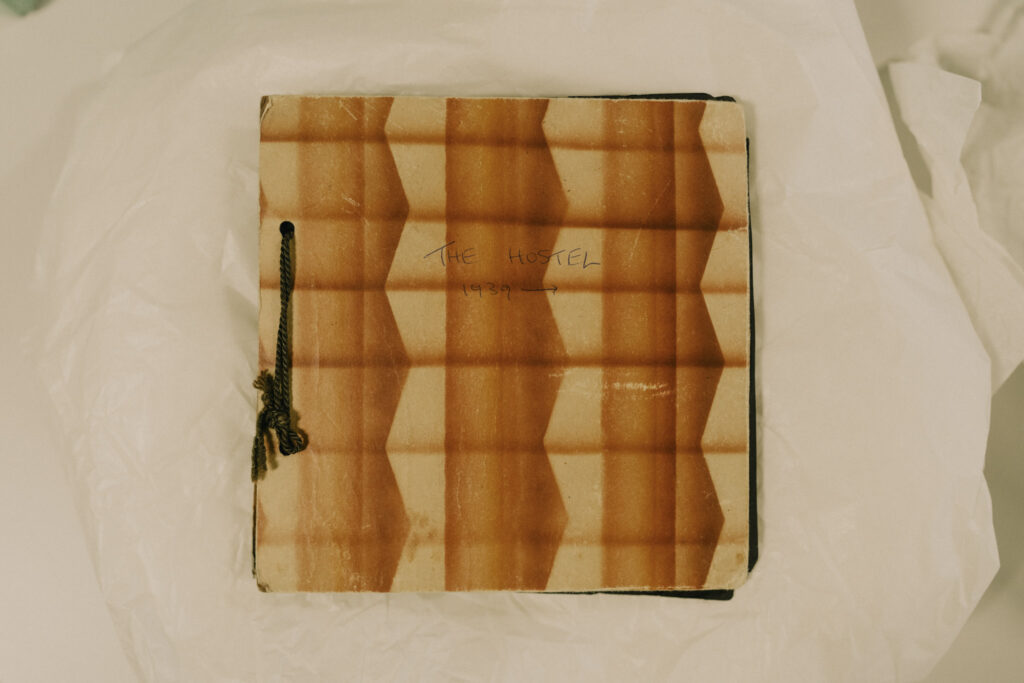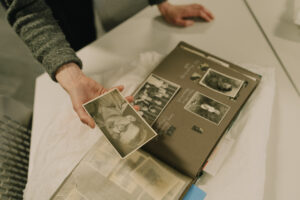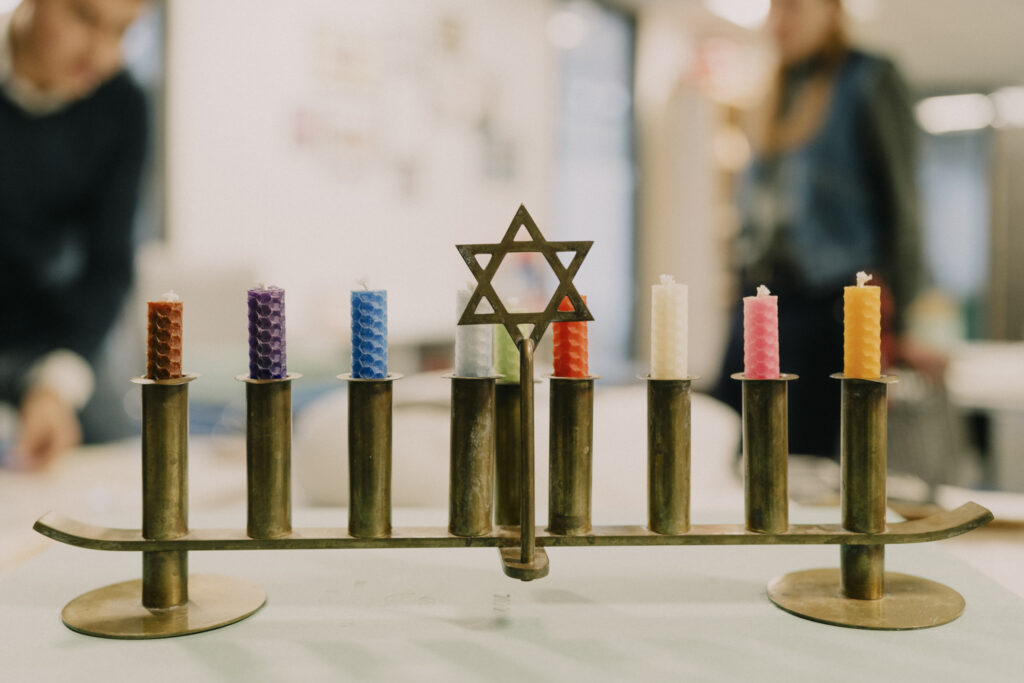Collection Encounter: Holocaust Centre North
Holocaust Centre North • Hidden Treasures/Drew Forsyth
“We started with friendship, people meeting for teas and coffees and then they wanted to start sharing their stories” – Hari Jonkers, Archivist at Holocaust Centre North
Community and friendship is at the heart of Holocaust Centre North. Its tagline is ‘a global history through local stories’ and any visit to the centre shows this to be true.
Housed on the University of Huddersfield campus, the centre’s permanent exhibition interweaves the historical facts of the Nazi rise to power and their genocidal policies with the individual, personal and powerful stories of 16 refugees and survivors who settled, at least for a time, in the north of England.
Their archive also reflects this connection with the local community and as it continues to grow, the staff and the mission remain focused on these connections and telling the stories of people within the broad sweep of history. These stories keep that history alive, not just to memorialise the past but also for new generations – those who are learning about this period of history for the first time and might recognise themselves in these refugee stories too.
An archive built on friendship
The original group of survivors met each other in Leeds around 1995. They came from all over Europe. Some arrived in England as independent refugees, others on the Kindertransports and others still had survived the camps. Together they found more survivors and formed the Holocaust Survivors Friendship Association (HSFA). Soon they began gathering their memories, documents, photographs and giving audio interviews. This became the backbone of the collection for Holocaust Centre North.
Hari stressed that everything collected has been given by the survivors and their relatives on their own terms – sometimes items are on loan for a while and it’s not until everyone agrees that anything is brought in permanently. They build a relationship with the survivors and their families, a friendship, just like that original group.

One of the hostel photo albums courtesy of Gail Simon • Hidden Treasures/Drew Forsyth
The Bradford Hostel
One such group of items are those related to the Bradford Jewish Refugees Hostel. The hostel was founded by textiles manufacturer Oswald Stroud who asked for donations from the local Jewish community and a house in Manningham was bought to house young people escaping Germany and Austria.
A couple, Herbert and Marie Eger, who were recent refugees from Berlin themselves, were employed to run it. Around 25 boys were housed there. Recently, the couple’s granddaughter, Gail, has given documents and memorabilia from her grandparents to the Centre including some 15 photo albums documenting both their lives in Germany before the war, their time at the hostel and beyond. It also includes letters from the boys where they talk about their daily routines and correspondence from them long after they had moved on.
One particularly interesting piece is the list of rules the boys had to abide by. These included not speaking German outside the hostel and walking to school in small groups. This was done to not cause too much attention and help the boys fit in. Some were even given anglicised names.
Hari mentioned how these experiences relate to school children visiting Holocaust Centre North. Huddersfield and West Yorkshire are very diverse areas of the country with waves of immigrant families settling there. The Centre sees part of its role is to talk about multicultural assimilation. “We ask them, how do you think you would feel if you were a refugee? And this probably happened to some of these children.”
We took a look at some of the photo albums and noticed how a lot of the boys were in uniform. Once they were old enough, a lot of them joined up but were put on restricted duties due to their refugee status. They went into the Pioneer Corp who were also known as ‘the diggers’ because that’s what they did – their service was spent digging trenches and other manual labour until they were “trusted” in normal platoons.
After the war, some of the boys remained local to Bradford and the North of England while others moved to America or Israel. In 1989 a reunion was organised which the BBC reported on. Hari is hoping that through their work with these documents and memories, they can find more of the boys and collect their stories too keeping the archive growing.

Hari showing us one of the photo albums courtesy of Gail Simon • Hidden Treasures/Drew Forsyth
The future of the archive
Meanwhile, Gail keeps finding more items from her grandparents’ lives. She told Hari she has home movies of them in Israel during the 1950s when they were visiting some of the boys who’d settled there. “Some of them originally had German names because they were German-Austrian and when they came here, their names were changed and when they moved to Israel they took on Hebrew names. So a different name for each stage of their life”
The Centre is also scanning the photographs Gail has lent them. For Hari, taking the photos out of the albums goes against her archivist instinct to keep the documents conserved as they are but they also want to know if there are names and dates on the back of them. Gail is writing a book and wants to trace more of her family relatives and friends.
For the Centre, it’s an opportunity to continue growing their digital collection. “We’re very much focused on digitisation because we’re midway through a three-year project called Homeward Bound… We published our first catalogue last year, which features descriptions of 70 collections. Actually, we’ve grown quite a lot – from a modest size but we’ve now got about 130 family collections.”
Their reasoning behind more digitisation is embedded in the community and friendship the entire organisation started with. A better, larger catalogue and digitised material means more people from around the world and even just in the local area can connect with those stories, find meaning and discover connections with their past and current community.
The same goes for the exhibition and the archive itself. The centre’s Director, Dr. Alessandro Bucci told us how proud they were to see people who told them very clearly they had a sense of insecurity about coming but that the centre’s outreach work helped them overcome it. They’re also encouraging those communities, especially newer refugees, to start collecting their own stories and showing them how Holocaust Centre North is an example of a DIY archive that has become an invaluable record of one community’s history. That every community has a history to be preserved and told.
One of the last items we looked at was a Menorah made by one of the boys at the hostel and given to Herbert and Marie. It’s a simple metal piece made in a metalworking class but the couple kept it. As Hari told us, “The hostel became the main family community unit.”

A handmade menorah, courtesy of Gail Simon • Hidden Treasures/Drew Forsyth
That legacy of community and support for refugees continues through spaces and archives like Holocaust Centre North. Stories from the past give connections to experiences of the present and friendship can still change lives.
“That’s one of the things I love about working here actually” said Hari, “It’s very much a living archive. It’s a bit cheesy but it’s true.”